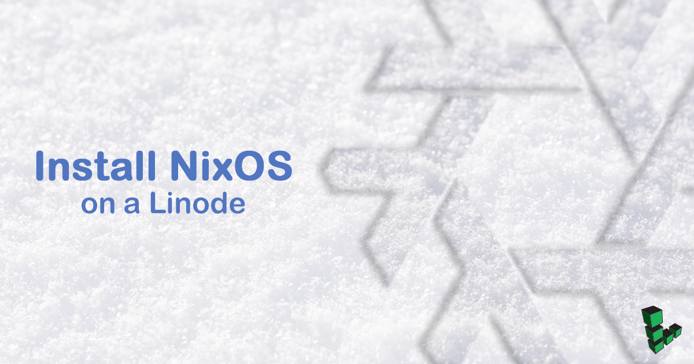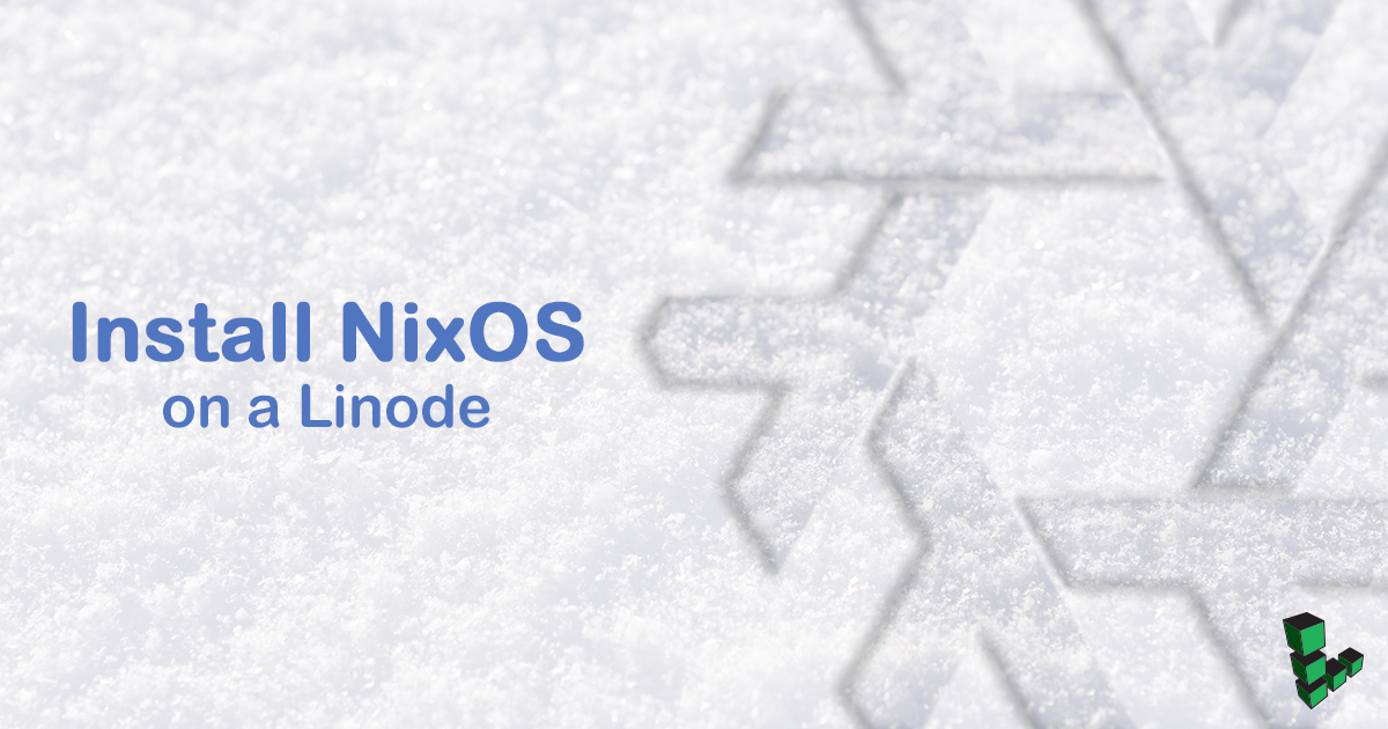Install and Configure NixOS on a Linode
Traducciones al EspañolEstamos traduciendo nuestros guías y tutoriales al Español. Es posible que usted esté viendo una traducción generada automáticamente. Estamos trabajando con traductores profesionales para verificar las traducciones de nuestro sitio web. Este proyecto es un trabajo en curso.



NixOS is a Linux distribution built on the Nix package manager. Nix focuses on functional programming concepts, such as immutability and determinism, that enable powerful system management techniques.
While Nix can be installed on any Linux system, NixOS takes these ideas a step further by extending them to the entire system, allowing configuration files and active state to be managed as well. This unique approach to system management has many advantages that can make deploying software and application updates easier.
Before You Begin
Familiarize yourself with LISH and GLISH to connect to your Linode. You will use them throughout this guide.
The NixOS manual is the main reference for NixOS. It explores the concepts at a high level and serves as a reference for some system configuration concepts. This should have everything you need to know to get started, but there may be some deeper concepts that are not thoroughly addressed. For more in-depth information, visit the NixOS and Nixpkgs manuals.
Prepare Your Linode
You can use a pre-existing Linode, or you can create a new one. If you’re using a pre-existing Linode, go to the Create Disks for Nix section, and resize your images into that approximate format.
Create a new Linode
To create a new Linode, go to the Create Linode page. Under Images, deselect the default by clicking X. Then select a region, plan, label, and tags (if desired). Click the Create button to start the server.
Create Disks for Nix
Create three disk images: One for the installer, one for a swap partition, and one for the root partition. Label them:
- Installer: A type
ext4disk, 1024 MB in size. - Swap: A
swapdisk no larger than 512 MB. - NixOS: A type
ext4disk which takes up all remaining space.
Create Configuration Profiles
Create two configuration profiles, one for the installer and one to boot NixOS. For each profile, disable all of the options under Filesystem/Boot Helpers and set the Configuration Profile to match the following:
Installer profile
- Label: Installer
- Kernel: Direct Disk
- /dev/sda: NixOS
- /dev/sdb: Swap
- /dev/sdc: Installer
- root / boot device: Standard: /dev/sdc
Boot profile
- Label: NixOS
- Kernel: GRUB 2
- /dev/sda: NixOS
- /dev/sdb: Swap
- root / boot device: Standard: /dev/sda
Prepare the Installer
In your browser, navigate to the NixOS download page and copy the URL from the Minimal installation CD, 64-bit Intel/AMD link.
Boot your Linode into rescue mode with the Installer disk mounted as
/dev/sda.Once in rescue mode, click the Launch Console link to launch the Finnix rescue console and run the following commands, replacing the URL with the latest 64-bit minimal installation image copied from the NixOS download page:
# Update SSL certificates to allow HTTPS connections: update-ca-certificates # set the iso url to a variable iso=<URL for nixos download> # Download the ISO, write it to the installer disk, and verify the checksum: curl -L $iso | tee >(dd of=/dev/sda) | sha256sumThe checksum should be the same as that in the contents of the checksum file linked next to the download link. Verify it before proceeding.
Install NixOS
Now that you have created the installer disk, you need to boot with the installer.
Boot the Installer
In your Linode’s dashboard, boot into your Installer configuration profile. Since the installer image isn’t configured to support SSH or the LISH console, connect to your Linode using GLISH.
Set up the Install Environment
Use sudo to become the root user for interactive use:
sudo -iMount the NixOS disk to which you are installing the distro as
/mnt:mount /dev/sda /mntEnable the swap disk you created earlier:
swapon /dev/sdbGenerate a starter configuration:
nixos-generate-config --root /mnt
Configure NixOS
Change to the configuration directory:
cd /mnt/etc/nixosWithin this directory there are two files: configuration.nix and hardware-configuration.nix. When realizing its configuration, NixOS only uses configuration.nix. It is common practice to keep a separate Nix file with hardware specific configuration and have the configuration.nix file source its contents.
Rewrite Device Identifiers
The nixos-generate-config command in the Set up the Install Environment section generated the configuration from hardware details it gathered automatically. It prefers to use UUIDs to identify disks, but since Linode is a virtual platform you can choose the device identifiers that disks get attached to.
Since you can modify these later, it is better to use the /dev/sdX identifiers where X is the assigned volume, like sda or sdb, to allow you to easily swap in backup disks without having to boot into rescue mode and rewrite the UUID to match the new disk:
Replace the contents of the fileSystems and swapDevices sections with the following:
- File: /mnt/etc/nixos/hardware-configuration.nix
1 2 3 4 5 6 7 8fileSystems."/" = { device = "/dev/sda"; fsType = "ext4"; }; swapDevices = [ { device = "/dev/sdb"; } ];
Enable LISH
The LISH console requires certain kernel and GRUB options to be configured in the hardware configuration. Place these lines anywhere within the curly braces { } that contain most of the existing configuration. Order doesn’t matter for Nix files, so group settings in a way that makes sense to you:
- File: /mnt/etc/nixos/hardware-configuration.nix
1 2 3 4 5 6boot.kernelParams = [ "console=ttyS0,19200n8" ]; boot.loader.grub.extraConfig = '' serial --speed=19200 --unit=0 --word=8 --parity=no --stop=1; terminal_input serial; terminal_output serial '';
Configure GRUB
When GRUB detects a partitionless disk, it will warn about the unreliability of blocklists. To force NixOS to ignore the warning and then continue, configure GRUB to use the
forceInstalloption. GRUB will run from the host machine and will read the GRUB file from the disk, so the GRUB on disk will never be used.boot.loader.grub.forceInstall = true;Set the timeout for GRUB to be lengthy enough to accommodate LISH connection delays. The following hardware configuration example sets a 10 second timeout. Again, these lines can be placed anywhere within the curly braces
{ }:- File: /mnt/etc/nixos/hardware-configuration.nix
1 2boot.loader.grub.device = "nodev"; boot.loader.timeout = 10;
Edit NixOS Configuration
At the end of the guide, you will create an image from this disk, which will allow you to deploy NixOS on Linode like any other distro. For this purpose it is better to make a general all-purpose image, so you won’t make any system-specific configuration changes, like adding users and SSH keys.
Most of these changes bring the NixOS defaults in line with how Linode’s standard images work for most distributions. These aren’t necessarily best practices, but they make a system that works as expected.
Configure the SSH daemon
Root logins via SSH are disabled by default. To access your Linode, enable root login during installation by editing the services.openssh lines. In NixOS version 23.x and later, the setting to permit root login is services.openssh.settings.PermitRootLogin. In earlier versions, this setting is services.openssh.permitRootLogin.
NixOS version 23.x or later:
- File: /mnt/etc/nixos/configuration.nix
1 2 3 4services.openssh = { enable = true; settings.PermitRootLogin = "yes"; };
NixOS version 22.x or earlier:
- File: /mnt/etc/nixos/configuration.nix
1 2 3 4services.openssh = { enable = true; permitRootLogin = "yes"; };
"no" after creating a limited user account. This prevents malicious actors from attempting to gain root access to your system.Disable Predictable Interface Names
Most of Linode’s default images have had systemd’s predictable interface names disabled. Because of this, most of Linode’s networking guides assume an interface of
eth0. Since your Linode runs in a virtual environment and will have a single interface, it won’t encounter the issues that predictable interface names were designed to solve. This change is optional, but may help troubleshooting later; add the following line:- File: /mnt/etc/nixos/configuration.nix
1networking.usePredictableInterfaceNames = false;
You will also need to change the name of the interface that DHCP is used on. Replace the contents of the existing block around
networking.useDHCPwith the following:- File: /mnt/etc/nixos/configuration.nix
1 2 3networking.useDHCP = false; # Disable DHCP globally as we will not need it. # required for ssh? networking.interfaces.eth0.useDHCP = true;
Install Diagnostic Tools
These tools are included on most Linode images, and are frequently used by Linode support when troubleshooting networking and host level issues. Add the following to your configuration to ensure these tools are installed:
- File: /mnt/etc/nixos/configuration.nix
1 2 3 4 5environment.systemPackages = with pkgs; [ inetutils mtr sysstat ];
Create a non-root user
Create a user to login as non-root as per the docs:
- File: /mnt/etc/nixos/configuration.nix
1 2 3 4 5 6 7users.users.alice = { isNormalUser = true; home = "/home/alice"; description = "Alice Foobar"; extraGroups = [ "wheel" "networkmanager" ]; openssh.authorizedKeys.keys = [ "ssh-dss AAAAB3Nza... alice@foobar" ]; };
(Use a secure set of keys such as that generated by ssh-keygen -t ed25519 -a 100 with no passphrase.)
Run the NixOS Installer
Install NixOS using the settings you configured:
nixos-installOnce complete, the installer will prompt you to set a root password.
NixOS is now installed and can be booted from the Boot profile created in Create Configuration Profiles.
Give your user a password and turn off ssh for root
Boot using the NixOS configuration, and give your user a password, for example:
passwd alicesshin with the user to test, then setpermitRootLoginto “no” in/etc/nixos/configuration.nix, and rebuild your config:sudo nixos-rebuild switch
Create an Image of your Linode
In this optional section, you’ll create a deployable disk image of NixOS.
Linode Images allows you to take snapshots of your system. These snapshots are limited to 2GB in size. The NixOS installation includes packages that were essential for the installation process, but aren’t needed for the running system. These can be removed after installation:
nix-collect-garbage -dThe
nix-collect-garbagecommand tells Nix to “garbage collect,” to remove any packages that the running system isn’t depending on. Usually when you upgrade or install packages, Nix will leave old versions intact so that you can easily roll back to them. Thenix-collect-garbagecommand invokes Nix’s garbage collector which automatically cleans up old packages.You may also want to go through and remove any log files that may be in
/var/log. While these are usually pretty small, because you are creating an image, it’s good to have as blank of a disk as possible:cd /var/logCreate an image of the NixOS disk using the Linode Images guide. Label the image according to the release of NixOS you installed. Now that you have created an image, you can select it in the distribution menu whenever you deploy a Linode.
Delete the Installer Disk and Profile
If you’re not confident with your install configuration, you can keep the installer and boot from it to reinstall adjusted configuration repeatedly.
Otherwise, you can now delete the installer disk and profile from your Linode using the Deleting a Configuration Profile and Deleting a Disk guides.
Remove the Installer disk and reclaim the storage that the NixOS installation was using:
- Go to your Linode’s dashboard and shutdown your Linode.
- Remove the Installer disk.
- Resize the NixOS disk to the maximum possible size.
Enable Longview Agent (optional)
After installation, Longview can be set up for your NixOS instance.
Add the following options to your
/mnt/etc/nixos/configuration.nix:- File: /mnt/etc/nixos/configuration.nix
1 2 3 4services.longview = { enable = true; apiKeyFile = "/var/lib/longview/apiKeyFile"; };
You will then have to create the directory and file from the above configuration and write your Longview api key to the file.
sudo mkdir /var/lib/longview export longview_key="01234567-89AB-CDEF-0123456789ABCDEF" # This is an example, fill with your own key echo $longview_key > /var/lib/longview/apiKeyFile | sudo tee /var/lib/longview/apiKeyFileReplace the value of
longview_keyabove with the one you got from Longview.
More Information
You may wish to consult the following resources for additional information on this topic. While these are provided in the hope that they will be useful, please note that we cannot vouch for the accuracy or timeliness of externally hosted materials.
This page was originally published on

